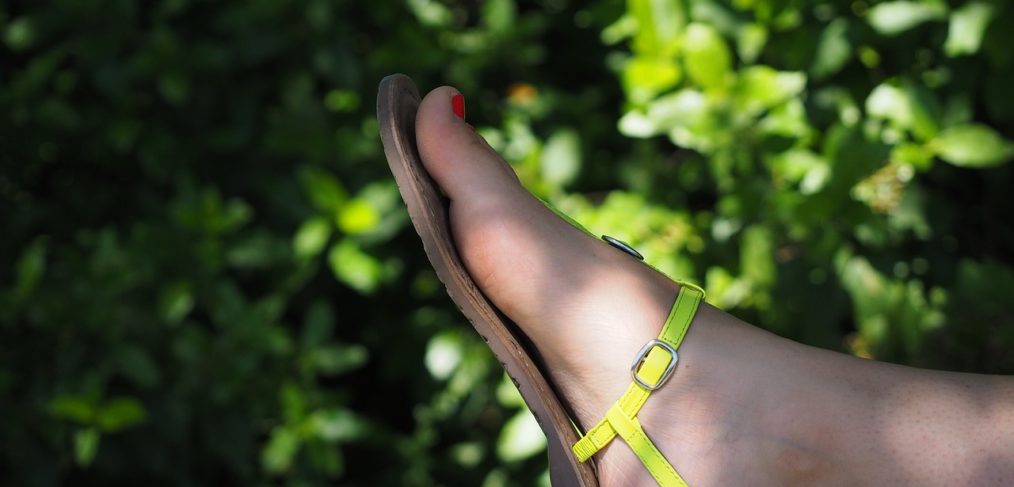
Eat for Beautiful Feet
Summer is here! Did you know you can eat for beautiful feet!
Are you embarrassed to go barefoot or wear sandals? Many common foot problems can be healed and prevented through dietary changes. Check out these 10 ways to eat for beautiful feet.
1. Rough Dry Heels
Dry, flaky heels and foot callouses are an early sign of essential fatty acid deficiency. Fatty acids are used to create the membranes around each and every cell in your body. Because your body prioritizes nutrients for vital organs, your skin will be one of the first place this lack shows up. So, avoid deep fried foods and hydrogenated fats. Instead, focus on including fish oil in your diet, and check with your practitioner about the use of flax seed oil or black current oil.
2. Foot Cramps
When cramping is infrequent and sporadic, you may simply be dehydrated. A tall glass of water may correct the situation without further problem. But if cramping occurs repeatedly, it may be a sign of mineral deficiency. Potassium, calcium, and magnesium are the most common electrolytes you need to keep your muscles contracting and relaxing properly. Therefore, you must eat mineral-rich leafy green vegetables frequently and don’t be shy about organ meats in your diet. Try adding a pinch of sea salt or a splash of lemon juice to your water. Avoid empty calories from nutrient poor foods such as chips, pop, and sweet treats.
Additionally, eating under stress keeps you from absorbing the minerals in your food. Take these four steps at meal time: sit down comfortably, breathe deeply, slow down, and chew thoroughly.
3. Itchy Feet
Most people consider itchy, scaly athlete’s foot to be an annoyance on the surface of the skin. But it could be a sign of an imbalanced gut flora. To keep your gut microbiome healthy and protect your feet from itchy fungus, first, stay away from simple, sugary carbohydrates. Second, eat lots of prebiotic plant fibers, such as garlic, onions, leeks, asparagus, Jerusalem artichoke, apples, and green vegetables to support microbial balance.
Thick, pimple-like itchy patches on your feet may be causes by psoriasis. As with rheumatoid arthritis, an over-reaction of the immune system causes psoriasis. Healing the gut is imperative to balancing the immune system. Particles that escape through a compromised gut are what’s over-stimulating the immune system. Gut-healing foods such as bone broth and licorice tea can be healing after the offending triggers are removed. A food-sensitivity test may be important to detect what your triggers are.
4. Sore Toe Joints
Achy joints, especially in the hands and feet, are often an early signal for rheumatoid arthritis, an autoimmune disease. This crippling disease results from a dysregulation of the immune system. To get the body back on track, the immune system needs foods high in micronutrients – vitamins, minerals, and phytochemicals. So, eat high-quality protein and lots of deeply-colored produce. Avoid the most common immune-triggering foods: gluten, dairy, soy, nuts, and corn.
5. Burning Feet
This sensation is common among diabetics. If you have not been diagnosed with this disease, check with your physician for blood sugar testing. In the meantime, eat foods rich in B vitamins and reduce your carbohydrate intake.
6. Foot Sores That Won’t Heal
This symptom is a major warning sign for diabetes. One in three Americans is diabetic and doesn’t know it. The greatest dietary contributor to this condition is an imbalance between carbohydrates and proteins and fats. Check the risk factors, and aim for no more than 40% of your calories from carbohydrate. Also, eat natural, unprocessed fats, such as olives, coconuts, avocados and butter, while avoiding hydrogenated and heat- or chemical-extracted oils. Finally, try to make at least 1/4 of your plate protein at every meal.
7. Pain in the Big Toe
Gout is a notorious cause of sudden pain in the big toe joint, along with redness and swelling. However, contrary to popular opinion, excessive protein is not always the cause of gout. In fact, drinking pop is a major contributor to this condition because the high fructose corn syrup breaks into purines in your body, resulting in uric acid build-up that settles in the joints. To maintain joint health, eat a balanced diet and limit your consumption of sweeteners.
8. Yellow Toenails
Fungal infections are usually the root cause of thickened yellow toenails. Treat as you would for athlete’s foot by reducing fungus-feeding foods: sweets, refined carbohydrates, and empty calorie foods. Focus on prebiotic vegetables. Lastly, eat probiotic rich foods such as kimchi, kombucha, kefir, and traditionally-fermented sauerkraut.
9. Spoon-shaped Toenails
If there has been no injury to the nail, iron deficiency is likely the cause this unusual shape. Your body absorbs heme iron, from animal products better than non-heme iron from plants. But aside from eating more red meat and organ meat, you can increase your iron absorption by consuming foods rich in vitamin C. For instance, include citrus fruits, berries, papaya, tomatoes, sweet potatoes, broccoli, cabbage, and dark green leafy vegetables. Also, don’t use acid blockers, over-the-counter heartburn remedies, or reflux medication, as these interfere with mineral absorption.
10. Blue toes
Toes that turn blue when exposed to cold might signal Raynaud’s disease. Raynaud’s is often linked to an autoimmune condition which requires gut healing, mineral-rich foods, and removal of the antigens. If you are fighting this disease, it is wise to contact a practitioner who can guide you through the dietary changes most appropriate for your unique biological make-up.
Eat for Beautiful Feet
In summary, they key to stylin’ in sandals is to eat a nutrient-dense whole foods diet. Remember to
- Include lots of fruits and vegetables, especially dark leafy greens and deeply-colored produce.
- Eat the right kind of fats – those that have not been processed or refined but occur naturally.
- Include enough high-quality protein.
- Limit carbohydrates to less than half of your calories.
- Eliminate sugar and empty carbohydrates.
